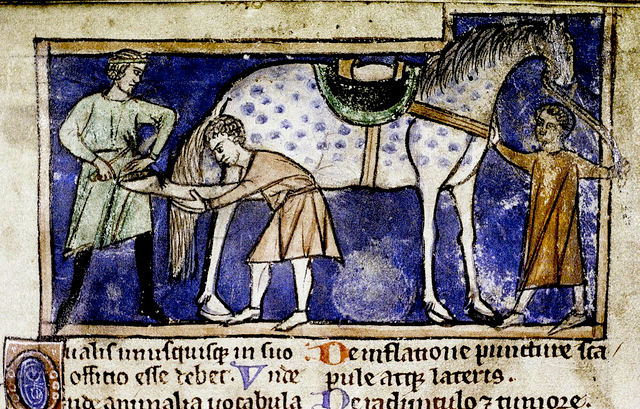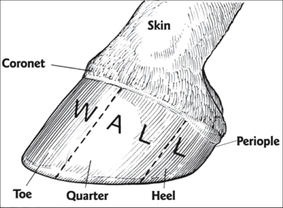'No hoof, no horse,' goes the common saying, which indicates how vital hoof care is to the soundness of your horse. For this reason, in Horsemanship Level 3 and up, there is at least one lesson in the curriculum (and a section of the exam) devoted solely to the foot and farriery. For level 3 you are required to know:
11. External parts of the hoof. Signs that trimming or re-shoeing is necessary
Parts of the Hoof
In the diagram on the right, you can see a number of anatomical points that you should be familiar with if you have taken Horsemanship Level 2, including:
- Bulb of heel
- Cleft of frog
- Bars
- White Line
- Sole
- Wall
- Frog
- Commissures
Missing from the diagram is the seat of corn (sometime called the angle of bar) which is the triangular point at which the wall and bars meet.
In addition you should know the anatomy of the outside of the foot, as seen in this diagram.
When to Call the Farrier
The walls of hooves are made of keratin, and are essentially very thick, hard fingernails. Like our nails, these are growing all the time and need trimming. But while long toenails may just make our footwear uncomfortable, for a horse, trims are necessary to maintain proper stride and hoof function. A hoof needs trimming every four to eight weeks, depending on time of year, amount of wear, and the horse's individual rate of hoof growth. Horses with imbalanced or diseased hooves will generally need more frequent care. If the horse wears shoes, these will need to be reset or replaced on the same schedule.
Signs a bare foot needs trimming are:
- the hoof wall is long (protruding past the sole by a centimetre or more)
- the hoof wall is starting to separate from the white line
- there are chips or cracks in the wall
- the quarters (sides) or heels are flaring outward
- the hoof has grown or been worn to an imbalanced or uneven shape
In addition, you can tell when a shod hoof needs re-shoeing when:
- the shoe is loose
- the walls have grown past the edges of the shoes
- the clenches (ends of the nails that hold the shoe on and protrude from the hoof 1/3 of the way up the wall) have risen or started to pull through the wall
- the shoe has been cast (thrown) -- ie, is missing
Do not worry if your horse's frogs have loose flaps of tissue. This is part of the natural sloughing process of the frog. Your farrier will tidy them up in order to check the frogs' health, but a ragged-looking frog is normal. Your farrier will be able to suggest an appropriate schedule for trimming based on your horse's foot health and growth patterns.
This concludes our journey through the Horsemanship 3 checklist for the Blue Spur. In January we will begin looking at the Riding Level 3 requirements.
Holiday Hiatus
Our last class for 2014 was on Sunday. Classes will start up again in February 2015. If you would like to book rides or do some private lessons with Jen, Kate or Stephanie over the next month and a half, email jen (at) academieduello.com. Flex pack credits may be used for private lessons.
Thank you to all the teachers who have worked hard to deliver great content throughout the year: Cassandra, Kat, Isabel, Eleanor, Kate, Stephanie, Devon, Greg, Matheus and Walker. You guys rock!
Lease Special
Need more practice time in the saddle? We have a winter special for Academie Duello students only during the months of December and January. Lease one of our school horses for one day per week for a cost of only $115 per month (saving $20 per month over regular rates), or $220 for the whole two month period for a total savings of $150!
Leases include one free lesson per month ($50 value), and additional lessons can be booked for a discounted rate of $35 each. You must have Riding and Horsemanship level 1 or the equivalent to qualify for a lease. Flex-pack credits may be applied to the lease. Contact Jen at jennifer(at)academieduello.com for more information.

